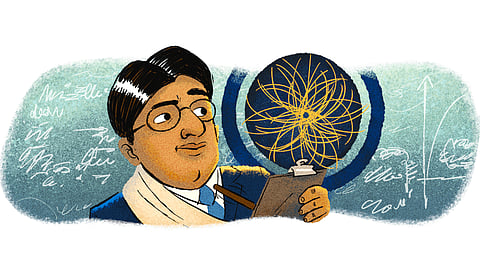

Satyendra Nath Bose was born on January 1, 1894, in Kolkata and is best known for his work on quantum mechanics in the early 1920s.
He was an adviser to the Council of Scientific and Industrial Research, and later became a Fellow of the Royal Society.
In 1954, he was awarded the Padma Vibhushan, by the Government of India and he was also accorded the honour of National Professor -- the highest for scholars in India.
He was a polymath (An individual whose knowledge spans a substantial number of subjects) and served on many research and development committees in sovereign India.
Bose's father, Surendranath Bose, was an accountant and he used to write an arithmetic problem for him to solve before leaving for work, which ignited Bose's interest in mathematics.
At age of 15, Bose began pursuing a B.Sc degree at Calcutta’s Presidency College and earned a Master’s in Applied Mathematics soon after at the University of Calcutta. He graduated top of his class in both the courses and established a reputation in academia.
By end of 1917, Bose began giving lectures on physics while teaching postgraduate students Planck’s radiation formula. He questioned the way particles were counted and began experimenting with his own theories.
In 1937, Rabindranath Tagore dedicated his only book on science, Visva–Parichay, to Satyendra Nath Bose.
Bose’s work led to many scientific breakthroughs, including the discovery of the particle accelerator and the God particle, Google said in a note accompanying the doodle.
The class of particles that obey Bose statistics, bosons, was named after Bose by Paul Dirac.
Bose who died in 1974, led institutions like the National Institute of Science, Indian Science Congress, Indian Physical Society, and the Indian Statistical Institute.
On this day in 1924, mathematician Satyendra Nath Bose sent his quantum formulations to great Albert Einstein who immediately recognized it as a significant discovery in quantum mechanics.
The formulations, documented in a paper titled Planck’s Law and the Hypothesis of Light Quanta, were applied by Einstein to a range of phenomena and his paper came to be recognised as one of the most important findings in quantum theory.
Inventions: Bose-Einstein condensate. Bose-Einstein statistics, Bose-Einstein distribution, Bose-Einstein correlations, Bose gas, Boson, Ideal Bose Equation of State, Photon gas
Are you in Chennai? Then click here to get our newspaper at your doorstep!
Visit news.dtnext.in to explore our interactive epaper!
Download the DT Next app for more exciting features!
Click here for iOS
Click here for Android